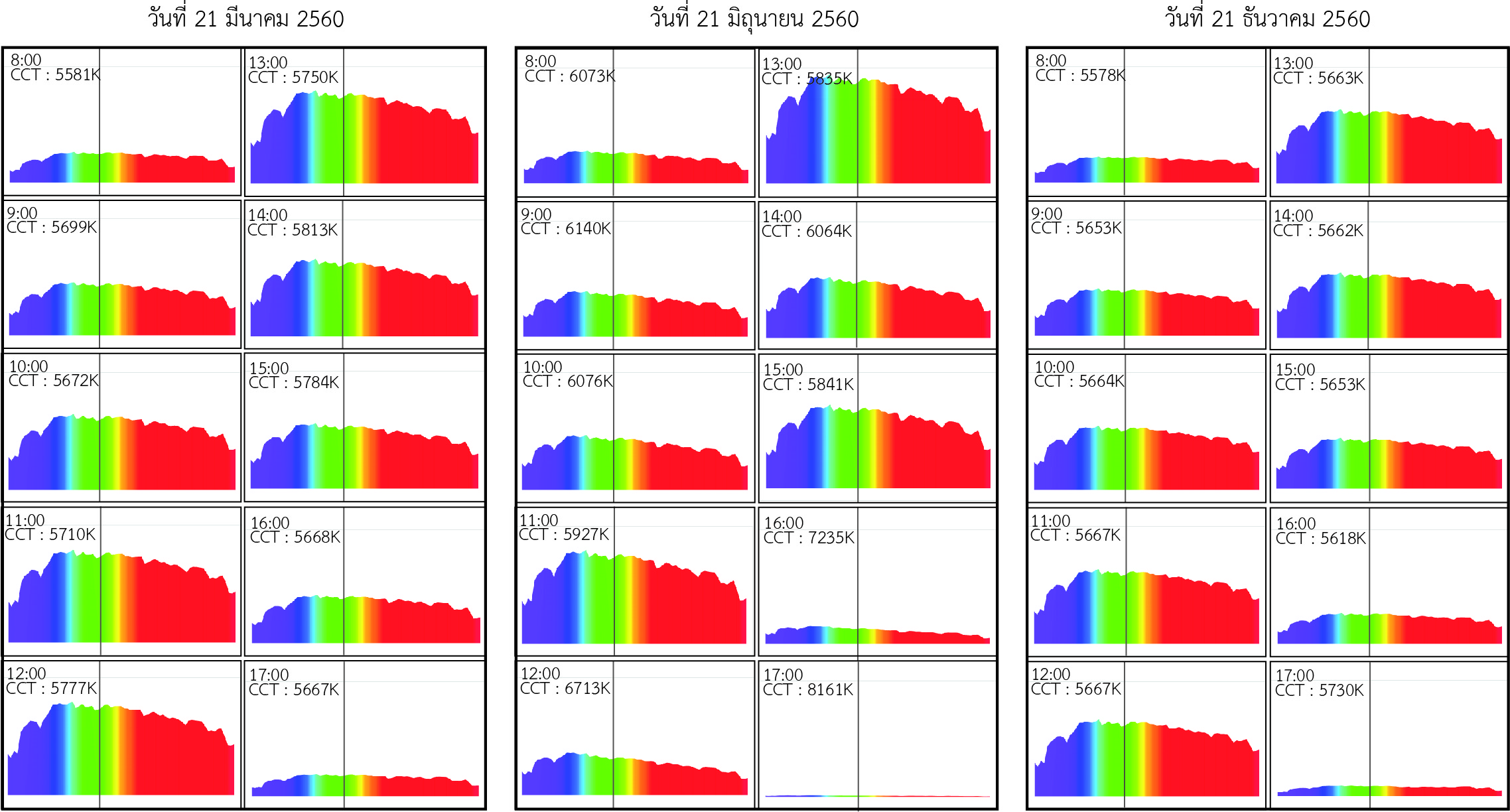Guidelines for Using Circadian Daylighting Evaluation in Thailand
Main Article Content
Abstract
Guidelines for using circadian daylighting evaluation mostly have been studied and developed from abroad which this subject has not yet been studied for its consistency and appropriateness for application in Thailand. Therefore, this research purposed to evaluate the use of the circadian lighting design’s guidelines related to the solar condition in Thailand to help all designers understand more about the guidelines and receive the evaluation results from the use of each guideline and to maximize guidelines for further use in the design by using the model with the ratio of 1: 1, 1: 2 and 2: 1 under an overcast sky and a clear sky with DIALux evo software to calculate the amount of CS and EML.
The finding was found that when the daylight is used to create the suitable environment for the circadian rhythm, it must make the horizontal illuminance higher than the average illuminance used in order to meet the minimum guideline which is the CS evaluation (Circadian Stimulus) that must have the horizontal illuminance of at least 935 lux between 8:00 a.m. and 12:00 p.m. for all areas to have a minimum amount of CS at 0.3 and 394 lux during 17:00 p.m. for all areas to have a minimum amount of CS at 0.2 and for the EML evaluation (Equivalent Melanopic Lux) must have the horizontal illuminance of at least 772 and 1197 lux throughout the day for all areas to have the EML of at least 150 EML for scoring 1 point and 240 EML for scoring 3 points, respectively. It can be said that the value is quite high and may cause discomfort from glare as well as the energy use of other related systems for the guidelines to use the daylight in Thailand that has the amount of light sufficient to be suitable for the circadian rhythm in the range of 1.5 - 3.0 m. from the edge of window, for the CS evaluation ranged between 1.0 - 2.0 m. from the edge of window, the EML evaluation that scored 1 point and the distance 0.5 - 1.0 m. from the edge of window, for the EML evaluation that scored 3 points which cannot cover most of the room. Nevertheless, determining the direction of sitting by window facing view will be able to help the building’s users who sit in the depths of the building to receive the daylight which is suitable for the circadian rhythm. As a result, it can be seen that the differences between CS and EML evaluations affected the selection and the use of daylight led to the arrangement of each area as different as each other. However, the evaluation of both guidelines required that every area must have the minimum amount of light to be able to succeed in the evaluation. If the artificial light is used together, it will make areas meet the guidelines and be suitable for the circadian rhythm effectively.
Downloads
Article Details

This work is licensed under a Creative Commons Attribution-NonCommercial-NoDerivatives 4.0 International License.
All material is licensed under the terms of the Creative Commons Attribution 4.0 International (CC-BY-NC-ND 4.0) License, unless otherwise stated. As such, authors are free to share, copy, and redistribute the material in any medium or format. The authors must give appropriate credit, provide a link to the license, and indicate if changes were made. The authors may do so in any reasonable manner, but not in any way that suggests the licensor endorses you or your use. The authors may not use the material for commercial purposes. If the authors remix, transform, or build upon the material, they may not distribute the modified material, unless permission is obtained from JARS. Final, accepted versions of the paper may be posted on third party repositories, provided appropriate acknowledgement to the original source is clearly noted.
References
Arunchanayuth, J. (2018). Design Guideline for Daylight and Artificial Light to Circadian Lighting of Office in Thailand. (Master’s Thesis). Faculty of Architecture and Planning, Thammasat University.
Arunchanayuth, J., & Srisutapan, A. (2019). “Design Guidelines of Circadian Daylighting for Office Building”. The 10th Built Environment Research Associates Conference 2019. 10 (10), 52–59.
Andersen, M., Gochenour, S. J., & Lockley, S. W. (2013). Modelling ‘non-visual’ effects of daylighting in a residential environment, Building and Environment, 70, 138-149.
Bellia, L., & Seraceni, M. (2013). A proposal for a simplified model to evaluate the circadian effects of light sources, Lighting Research and Technology. 2014, 46, 493-505.
Bommel, V. W., & Van Den Beld, G. (2004). Lighting for work: a review of visual and biological effects, Lighting Research and Technology, 36, 255-269.
British Standards Institution. (2011). BS EN-12461-1 Light and lighting: Lighting of work places.
Illuminating Engineering Society. (2017). ANSI IES RP-16-17 Nomenclature and Definitions for Illuminating Engineering. USA.
Khademagha, P., Aries, M. B. C., Rosemann, A. L. P., & Van Loenen, E. J. (2016). Implementing non image-forming effects of light in the built environment: A review on what we need, 265-271.
Konis, K. (2018). Field evaluation of the circadian stimulus potential of daylit and non-daylit spaces in dementia care facilities, Building and Environment, 135, 112–123.
Konis, K. (2016). A novel circadian daylight metric for building design and evaluation, Building and Environment, 113 (2017), 22-38.
Kozakov, R., Schopp, H., Franke, St., Stoll, C., & Kunz, D. (2010). Modification of light sources for appropriate biological action, Journal of Physics D Applied Physics, 43(23), 1-16.
Münch, M., Kobialka, S., Steiner, R., Oelhafen, P., Wirz Justice, A., & Cajochen, C. (2006). Wavelength-dependent effects of evening light exposure on sleep architecture and sleep EEG power density in men, American Journal of Physiology: Regulatory, Integrative and Comparative Physiology, 290(5), 1421-1428.
Rea, M. S., & Figueiro, M. G. (2018). Light as a circadian stimulus for architecture lighting, Lighting Research and Technology, 50, 497–510.
The Lighting Research Center. (2016). How to use the look-up chart. Retrived September 2, 2018 from https://www.lrc.rpi.edu/programs/lightHealth/pdf/LookUpTable_Indirect.pdf
The International WELL Building Institute. (2019). WELL Building Standard Q2 2019.


